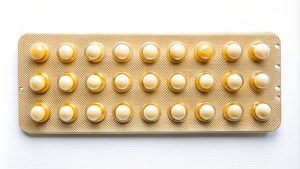 The combined contraceptive pill is a tablet that contains artificial versions of the two female hormones, oestrogen and progestogen. You need to take the pill at around the same time each day.
The combined contraceptive pill is a tablet that contains artificial versions of the two female hormones, oestrogen and progestogen. You need to take the pill at around the same time each day.
When taken correctly, the pill is over 99% effective at preventing pregnancy. This means that fewer than 1 in 100 people who use the combined pill as contraception will get pregnant in a year.
In real world use, about 9 in 100 people who use the combined pill a year become pregnant due to incorrect use such as forgetting to take pills (91% effective).
-
How does it work?
The combined pill releases the artificial form of the hormones – oestrogen and progesterone – which are absorbed into your body. It works by:
- stopping ovulation (an egg being released from your ovaries);
- thickening the mucus at the neck of the womb (uterus) so it is difficult for sperm to enter the womb;
- thinning the lining of the womb and this prevents a fertilised egg from. settling (implanting) in the womb
-
Advantages
- It does not interrupt sex.
- It often reduces bleeding and period pain, and may help with premenstrual symptoms.
-
Disadvantages
- If you miss a pill, or are vomiting or have severe diarrhoea, it can be less effective.
- It is not suitable if you smoke and are over 35 years of age.
- It is not suitable if you are obese.
- It may not be suitable if you are breastfeeding.
- Its effectiveness may be reduced by taking certain medications.
- It does not protect against sexually transmitted infections.
-
Where to get it?
Contraception services are free and confidential.
You can get the combined pill from:- sexual health clinics, also called family planning or contraception clinics;
- GP surgeries.






